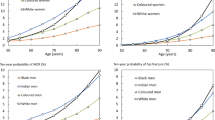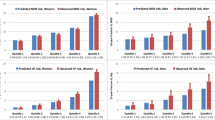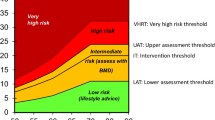Abstract
Summary
We describe the creation of a FRAX® model for the assessment of fracture probability in Canadian men and women, calibrated from national hip fracture and mortality data. This FRAX tool was used to examine possible thresholds for therapeutic intervention in Canada in two large complementary cohorts of women and men.
Objective
To evaluate a Canadian World Health Organization (WHO) fracture risk assessment (FRAX®) tool for computing 10-year probabilities of osteoporotic fracture.
Methods
Fracture probabilities were computed from national hip fracture data (2005) and death hazards (2004) for Canada. Probabilities took account of age, sex, clinical risk factors (CRFs), and femoral neck bone mineral density (BMD). Treatment implications were studied in two large cohorts of individuals age 50 years and older: the population-based Canadian Multicentre Osteoporosis Study (4,778 women and 1,919 men) and the clinically referred Manitoba BMD Cohort (36,730 women and 2,873 men).
Results
Fracture probabilities increased with age, decreasing femoral neck T-score, and number of CRFs. Among women, 10.1–11.3% would be designated high risk based upon 10-year major osteoporotic fracture probability exceeding 20%. A much larger proportion would be designated high risk based upon 10-year hip fracture probability exceeding 3% (25.7–28.0%) or osteoporotic BMD (27.1–30.9%), and relatively few from prior hip or clinical spine fracture (1.6–4.2%). One or more criteria for intervention were met by 29.2–34.0% of women excluding hip fracture probability (35.3–41.0% including hip fracture probability). Lower intervention rates were seen among CaMos (Canadian Multicentre Osteoporosis Study) men (6.8–12.9%), but in clinically referred men from the Manitoba BMD Cohort, one or more criteria for high risk were seen for 26.4% excluding hip fracture probability (42.4% including hip fracture probability).
Conclusions
The FRAX tool can be used to identify intervention thresholds in Canada. The FRAX model supports a shift from a dual X-ray absorptiometry (DXA)-based intervention strategy, towards a strategy based on fracture probability for a major osteoporotic fracture.



Similar content being viewed by others
References
Tenenhouse A, Joseph L, Kreiger N et al (2000) Estimation of the prevalence of low bone density in Canadian women and men using a population-specific DXA reference standard: the Canadian Multicentre Osteoporosis Study (CaMos). Osteoporos Int 11:897–904
Leslie WD, O’Donnell S, Lagace C et al (2009) Population-based Canadian hip fracture rates with international comparisons. Osteoporos Int 21:1317–1322
Wiktorowicz ME, Goeree R, Papaioannou A et al (2001) Economic implications of hip fracture: health service use, institutional care and cost in Canada. Osteoporos Int 12:271–278
Papaioannou A, Adachi JD, Parkinson W et al (2001) Lengthy hospitalization associated with vertebral fractures despite control for comorbid conditions. Osteoporos Int 12:870–874
Center JR, Nguyen TV, Schneider D et al (1999) Mortality after all major types of osteoporotic fracture in men and women: an observational study. Lancet 353:878–882
Johnell O, Kanis JA, Oden A et al (2004) Mortality after osteoporotic fractures. Osteoporos Int 15:38–42
Ioannidis G, Papaioannou A, Hopman WM et al (2009) Relation between fractures and mortality: results from the Canadian Multicentre Osteoporosis Study. CMAJ 181:265–271
Kanis JA, Oden A, Johnell O et al (2003) The components of excess mortality after hip fracture. Bone 32:468–473
Kanis JA, Oden A, Johnell O et al (2004) Excess mortality after hospitalisation for vertebral fracture. Osteoporos Int 15:108–112
Adachi JD, Ioannidis G, Berger C et al (2001) The influence of osteoporotic fractures on health-related quality of life in community-dwelling men and women across Canada. Osteoporos Int 12:903–908
Hallberg I, Rosenqvist AM, Kartous L et al (2004) Health-related quality of life after osteoporotic fractures. Osteoporos Int 15:834–841
Kanis JA, Melton LJ III, Christiansen C et al (1994) The diagnosis of osteoporosis. J Bone Miner Res 9:1137–1141
Looker AC, Wahner HW, Dunn WL et al (1998) Updated data on proximal femur bone mineral levels of US adults. Osteoporos Int 8:468–489
Kanis JA, McCloskey EV, Johansson H et al (2008) A reference standard for the description of osteoporosis. Bone 42:467–475
Cranney A, Jamal SA, Tsang JF et al (2007) Low bone mineral density and fracture burden in postmenopausal women. CMAJ 177:575–580
Kanis JA, Oden A, Johnell O et al (2007) The use of clinical risk factors enhances the performance of BMD in the prediction of hip and osteoporotic fractures in men and women. Osteoporos Int 18:1033–1046
Kanis JA, Oden A, Johansson H et al (2009) FRAX and its applications to clinical practice. Bone 44:734–743
Kanis JA, Johnell O, De Laet C et al (2002) International variations in hip fracture probabilities: implications for risk assessment. J Bone Miner Res 17:1237–1244
Kanis JA, Johnell O, Oden A et al (2008) FRAX and the assessment of fracture probability in men and women from the UK. Osteoporos Int 19:385–397
Dawson-Hughes B, Tosteson AN, Melton LJ III et al (2008) Implications of absolute fracture risk assessment for osteoporosis practice guidelines in the USA. Osteoporos Int 19:449–458
Fujiwara S, Nakamura T, Orimo H et al (2008) Development and application of a Japanese model of the WHO fracture risk assessment tool (FRAX). Osteoporos Int 19:429–435
Lippuner K, Johansson H, Kanis JA et al (2009) Remaining lifetime and absolute 10-year probabilities of osteoporotic fracture in Swiss men and women. Osteoporos Int 20:1131–1140
Siminoski K, Leslie WD, Frame H et al (2005) Recommendations for bone mineral density reporting in Canada. Can Assoc Radiol J 56:178–188
Dawson-Hughes B (2008) A revised clinician’s guide to the prevention and treatment of osteoporosis. J Clin Endocrinol Metab 93:2463–2465
Dawson-Hughes B, Looker AC, Tosteson AN et al (2010) The potential impact of new National Osteoporosis Foundation guidance on treatment patterns. Osteoporos Int 21:41–52
Kanis JA, Johansson H, Oden A et al (2010) The effects of a FRAX® revision for the USA. Osteoporos Int 21:35–40
Ettinger B, Black DM, Dawson-Hughes B et al (2010) Updated fracture incidence rates for the US version of FRAX. Osteoporos Int 21:25–33
Richards J, Brown A, Homan C (2001) The data quality study of the Canadian discharge abstract database: a methodological perspective. Proceedings of Statistics Canada Symposium: Achieving data quality in a statistical agency. Statistics Canada, Ottawa Last accessed: June 6, 2009. URL: http://secure.cihi.ca/cihiweb/en/downloads/quality_dadconfpaper_e.pdf
Canadian Institute for Health Information (2008) Quality Assurance Processes Applied to the Discharge Abstract and Hospital Morbidity Databases. CIHI, Ottawa Last accessed: Aug. 3, 2009. URL: http://secure.cihi.ca/cihiweb/en/downloads/quality_assurance_proc_apr08_e.pdf
Kreiger N, Tenenhouse A, Joseph L et al (1999) Research notes: the Canadian Multicentre Osteoporosis Study (CaMos)—background, rationale, methods. Can J Aging 18:376–387
Genant HK (1995) Universal standardization for dual X-ray absorptiometry: patient and phantom cross-calibration results. J Bone Miner Res 10:997–998
Berger C, Langsetmo L, Joseph L et al (2008) Change in bone mineral density as a function of age in women and men and association with the use of antiresorptive agents. Can Med Assoc J 178:1660–1668
Leslie WD, Metge C (2003) Establishing a regional bone density program: lessons from the Manitoba experience. J Clin Densitom 6:275–282
Leslie WD, MacWilliam L, Lix L et al (2005) A population-based study of osteoporosis testing and treatment following introduction of a new bone densitometry service. Osteoporos Int 16:773–782
Leslie WD, Caetano PA, MacWilliam LR et al (2005) Construction and validation of a population-based bone densitometry database. J Clin Densitom 8:25–30
Leslie WD (2006) The importance of spectrum bias on bone density monitoring in clinical practice. Bone 39:361–368
Roos NP, Shapiro E (1999) Revisiting the Manitoba Centre for Health Policy and Evaluation and its population-based health information system. Med Care 37:JS10–JS14
Giangregorio L, Leslie WD (2010) Time since prior fracture is a risk modifier for ten year osteoporotic fractures. J Bone Miner Res (in press)
Leslie WD, Lix LM, Johansson H, Oden A, McCloskey E, Kanis JA (2010) Independent clinical validation of a Canadian FRAX® Tool: fracture prediction and model calibration. J Bone Miner Res
Kanis JA (2007) WHO Scientific group on the assessment of osteoporosis at primary health care level. Brussels, Belgium
Johansson H, Kanis JA, Oden A et al (2009) BMD, clinical risk factors and their combination for hip fracture prevention. Osteoporos Int 20:1675–1682
Kanis JA, McCloskey EV, Johansson H et al (2008) Case finding for the management of osteoporosis with FRAX((R))—assessment and intervention thresholds for the UK. Osteoporos Int 19:1395–1408
Leslie WD, Siminoski K, Brown JP (2007) Comparative effects of densitometric and absolute fracture risk classification systems on projected intervention rates in postmenopausal women. J Clin Densitom 10:124–131
Richards JB, Leslie WD, Joseph L et al (2007) Changes to osteoporosis prevalence according to method of risk assessment. J Bone Miner Res 22:228–234
Lyles KW, Colon-Emeric CS, Magaziner JS et al (2007) Zoledronic acid and clinical fractures and mortality after hip fracture. N Engl J Med 357:1799–1809
Kanis JA, Barton IP, Johnell O (2005) Risedronate decreases fracture risk in patients selected solely on the basis of prior vertebral fracture. Osteoporos Int 16:475–482
Kanis JA, Johansson H, Oden A et al (2009) Bazedoxifene reduces vertebral and clinical fractures in postmenopausal women at high risk assessed with FRAX. Bone 44:1049–1054
McCloskey EV, Johansson H, Oden A et al (2009) Ten-year fracture probability identifies women who will benefit from clodronate therapy—additional results from a double-blind, placebo-controlled randomised study. Osteoporos Int 20:811–817
Tosteson AN, Melton LJ III, Dawson-Hughes B et al (2008) Cost-effective osteoporosis treatment thresholds: the United States perspective. Osteoporos Int 19:437–447
Tosteson AN, Burge RT, Marshall DA et al (2008) Therapies for treatment of osteoporosis in US women: cost-effectiveness and budget impact considerations. Am J Manag Care 14:605–615
Donaldson MG, Cawthon PM, Lui LY et al (2009) Estimates of the proportion of older white women who would be recommended for pharmacologic treatment by the new U.S. National Osteoporosis Foundation Guidelines. J Bone Miner Res 24:675–680
Fraser LA, Langsetmo L, Berger C et al (2010) Fracture prediction and calibration of a Canadian FRAX® tool: a population-based report from CaMos. Osteoporos Int (in press)
Leslie WD, Lix LM, Johansson H et al (2010) Independent clinical validation of a Canadian FRAX((R)) tool: Fracture prediction and model calibration. J Bone Miner Res [epub ahead of print]
Acknowledgements
The development of FRAX® was in part supported by a non restricted grant from the International Osteoporosis Foundation and the European Society for Clinical and Economic Aspects of Osteoporosis and Osteoarthritis. The hip fracture and mortality statistics were generously provided by the Public Health Agency of Canada using manipulated Canadian Institutes of Health Information data. We thank all those participants in CaMos whose careful responses and attendance made this analysis possible. The authors are indebted to Manitoba Health for the provision of data (HIPC File No. 2007/2008-49). The results and conclusions are those of the authors, and no official endorsement by Manitoba Health is intended or should be inferred. This article has been reviewed and approved by the members of the Manitoba Bone Density Program Committee. The analyses and conclusions in this report reflect the opinions of individual experts and not their affiliated organizations.
Conflicts of interest
William D. Leslie
Speaker fees and unrestricted research grants from Merck Frosst Canada Ltd; unrestricted research grants from Sanofi-Aventis, Procter & Gamble Pharmaceuticals Canada, Inc., Novartis, Amgen Pharmaceuticals Canada, Inc., Innovus 3M, Genzyme Canada; advisory boards for Genzyme Canada, Novartis, and Amgen Pharmaceuticals Canada, Inc.
Lisa M. Lix
Unrestricted research grants from Amgen Pharmaceuticals Canada, Inc. and innovus 3M.
David Goltzman
Consultant for Eli Lily, Novartis, Merck, Proctor & Gamble, and Amgen.
David A. Hanley
Consultant and grants from Amgen, Eli Lilly, Merck, Novartis, Proctor & Gamble, Warner-Chilcott, Sanofi-Aventis, Servier, Wyeth-Ayerst, Nycomed.
Jonathan D. Adachi
Consultant/Speaker or research grants from: Amgen, Astra Zeneca, Eli Lilly, GSK, Merck, Novartis, Nycomed, Pfizer, Procter & Gamble, Roche, Sanofi Aventis, Servier, Wyeth, Bristol-Myers Squibb.
Eugene McCloskey
Speaker fees and/or unrestricted research grants from Novartis, Amgen, AstraZeneca, Pfizer, Bayer, Procter & Gamble, Lilly, Roche, Servier and Hologic.
John A Kanis
Nothing to declare for FRAX and the context of this paper.
Others: None
Sources of support
None.
Author information
Authors and Affiliations
Corresponding author
Additional information
CaMos Research Group
David Goltzman (co-principal investigator, McGill University), Nancy Kreiger (co-principal investigator, Toronto), Alan Tenenhouse (principal investigator emeritus, Toronto). CaMos Coordinating Centre, McGill University, Montreal, Quebec: Suzette Poliquin (national coordinator), Suzanne Godmaire (research assistant), Claudie Berger (study statistician). Memorial University, St. John’s Newfoundland: Carol Joyce (director), Christopher Kovacs (co-director), Emma Sheppard (coordinator). Dalhousie University, Halifax, Nova Scotia: Susan Kirkland, Stephanie Kaiser (co-directors), Barbara Stanfield (coordinator). Laval University, Quebec City, Quebec: Jacques P. Brown (director), Louis Bessette (co-director), Marc Gendreau (coordinator). Queen’s University, Kingston, Ontario: Tassos Anastassiades (director), Tanveer Towheed (co-director), Barbara Matthews (coordinator). University of Toronto, Toronto, Ontario: Bob Josse (director), Sophie A Jamal (co-director), Tim Murray (past director), Barbara Gardner-Bray (coordinator). McMaster University, Hamilton, Ontario: Jonathan D. Adachi (director), Alexandra Papaioannou (co-director), Laura Pickard (coordinator). University of Saskatchewan, Saskatoon, Saskatchewan: Wojciech P. Olszynski (director), K. Shawn Davison(co-director), Jola Thingvold (coordinator). University of Calgary, Calgary, Alberta: David A. Hanley (director), Jane Allan (coordinator). University British Columbia, Vancouver, British Columbia: Jerilynn C. Prior (director), Milan Patel (co-director),Yvette Vigna (coordinator); Brian C. Lentle (radiologist).
Rights and permissions
About this article
Cite this article
Leslie, W.D., Lix, L.M., Langsetmo, L. et al. Construction of a FRAX® model for the assessment of fracture probability in Canada and implications for treatment. Osteoporos Int 22, 817–827 (2011). https://doi.org/10.1007/s00198-010-1464-2
Received:
Accepted:
Published:
Issue Date:
DOI: https://doi.org/10.1007/s00198-010-1464-2




